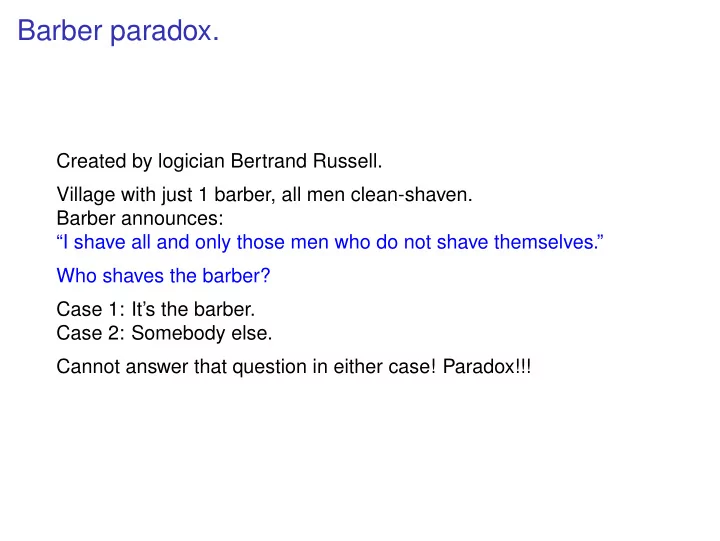

Barber paradox. Created by logician Bertrand Russell. Village with just 1 barber, all men clean-shaven. Barber announces: “I shave all and only those men who do not shave themselves.” Who shaves the barber? Case 1: It’s the barber. Case 2: Somebody else. Cannot answer that question in either case! Paradox!!!
Russell’s Paradox. Naive Set Theory: Any definable collection is a set. ∃ y ∀ x ( x ∈ y ⇐ ⇒ P ( x )) (1) y is the set of elements that satisfies the proposition P ( x ) . P ( x ) = x �∈ x . There exists a y that satisfies statement 1 for P ( · ) . Take x = y . y ∈ y ⇐ ⇒ y �∈ y . Oops!
Is this stuff actually useful? Verify that my program is correct! Check that the compiler works! How about.. Check that the compiler terminates on a certain input. HALT ( P , I ) P - program I - input. Determines if P ( I ) ( P run on I ) halts or loops forever. Notice: Need a computer ...with the notion of a stored program!!!! (not an adding machine! not a person and an adding machine.) Program is a text string. Text string can be an input to a program. Program can be an input to a program.
Implementing HALT. HALT ( P , I ) P - program I - input. Determines if P ( I ) ( P run on I ) halts or loops forever. Run P on I and check! How long do you wait?
Halt does not exist. HALT ( P , I ) P - program I - input. Determines if P ( I ) ( P run on I ) halts or loops forever. Theorem: There is no program HALT. Proof Idea: Proof by contradiction, use self-reference.
Halt and Turing. Proof: Assume there is a program HALT ( · , · ) . Turing(P) 1. If HALT(P ,P) =“halts”, then go into an infinite loop. 2. Otherwise, halt immediately. Assumption: there is a program HALT. There is text that “is” the program HALT. There is text that is the program Turing. Can run Turing on Turing! Does Turing(Turing) halt? Turing(Turing) halts = ⇒ then HALT(Turing, Turing) = halts = ⇒ Turing(Turing) loops forever. Turing(Turing) loops forever = ⇒ then HALT(Turing, Turing) � = halts = ⇒ Turing(Turing) halts. Contradiction. Program HALT does not exist!
Another view of proof: diagonalization. Any program is a fixed length string. Fixed length strings are enumerable. Program halts or not any input, which is a string. P 1 P 2 P 3 ··· P 1 H H L ··· P 2 L L H ··· P 3 L H H ··· . . . . ... . . . . . . . . Halt(P ,P) - diagonal. Turing - is not Halt. and is different from every P i on the diagonal. Turing is not on list. Turing is not a program. Turing can be constructed from Halt. Halt does not exist!
Turing machine. A Turing machine. – an (infinite) tape with characters – be in a state, and read a character – move left, right, and/or write a character. Universal Turing machine – an interpreter program for a Turing machine – where the tape could be a description of a ... Turing machine! Now that’s a computer!
Church, G¨ odel and Turing. Church proved an equivalent theorem. (Previously.) Used λ calculus....which is... a programming language!!! Just like Python, C, Javascript, .... G¨ odel: Incompleteness theorem. Any formal system either is inconsistent or incomplete. Inconsistent: A false sentence can be proven. Incomplete: There is no proof for some sentence in the system. Along the way: “built” computers out of arithmetic. Showed that every mathematical statement corresponds to an ....natural number!!!!
Summary: computability. Computer Programs are interesting objects. Mathematical objects. Formal Systems. Computer Programs cannot completely “understand” computer programs. Example: no computer program can tell if any other computer program HALTS. Proof Idea: Diagonalization. Program: Turing (or DIAGONAL) takes P . Assume there is HALT. DIAGONAL flips answer. Loops if P halts, halts if P loops. What does Turing do on turing? Doesn’t loop or HALT. HALT does not exist! More on this topic in CS 172. Computation is a lens for other action in the world.
Recommend
More recommend